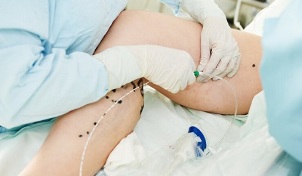
Signs of varicose veins in the legs in women are often found - this pathology is detected in almost one in three women. This disease, accompanied by expansion of the lumen and thinning of the walls of the venous vessels, leads not only to the appearance of aesthetic defects, but is also accompanied by pain and malnutrition of the tissues of the lower extremities. As a result, if left untreated, the woman may develop trophic ulcers in the legs, which cause even more serious complications. Therefore, the start of varicose vein treatment should always be punctual.
The signs of varicose veins on the legs in women are not always noticeable in the early stages - sometimes the disease lasts for a long time.
Causes and early signs
The leg veins are affected by varicose veins under the influence of the following factors:
- overweight;
- heredity;
- sedentary lifestyle;
- long stay in a static position;
- pregnancy;
- childbirth;
- taking contraceptives in high doses;
- increased pressure in the abdominal cavity with frequent or prolonged coughing, sneezing or constipation;
- overload during physical training or exertion;
- leg injuries;
- pelvic pathology;
- excessive use of tanning or heat treatments;
- wear uncomfortable shoes;
- the habit of sitting with your legs crossed;
- alcohol abuse;
- old age.
Due to the increase in pressure in the venous vessels and the stagnation of blood, the vessels become distended, the blood flow in them changes direction and flow rate, as the vessel walls change tone and the valves stop workingusually. As a result, changes in the veins lead to the development of a vicious circle in hemodynamics and other functions of the venous vessels.
In the early stages of varicose veins, blood flow can still be compensated by conservative means - wearing compression underwear, gymnastics and using venotonics. However, as the disease progresses, changes in the structure of the veins become irreversible and can only be removed surgically.
The symptoms of varicose veins can significantly disturb the normal rhythm of life.
The following manifestations can become the first signs of varicose veins in the legs:

- weight on the legs;
- the appearance of telangiectasias - spider veins and meshes of different colors (bluish, red, black);
- feeling of satiety during a long stay in an immobile position (sitting, standing);
- seizures at night;
- symptom relief after walking or resting in a horizontal position.
Often, the first manifestations of this common illness are attributed to fatigue, and a visit to the doctor can be postponed until the serious consequences of the illness appear. As the expansion of the venous walls progresses, the symptoms become more pronounced and then new ones are added to the above manifestations.
Symptoms
The increase in varicose veins in later stages is manifested by the following symptoms:
- rapid fatigue in the legs; pain;
- feeling full of fluid;
- swelling of soft tissues after exertion;
- translucency and protrusion of large veins above the skin;
- itchy skin;
- bruises due to rupture of large vessels;
- peeling of the skin;
- hair loss;
- trophic ulcers.
In the context of varicose veins in women, blood clots - thrombi - can form in the lumen of the veins. When they migrate through the bloodstream, consequences of various severities arise: thrombosis, flembothrombosis, development of cardiovascular diseases, opening and suppuration of ulcers, blood clots entering the vessels of the heart or lungs.
Diagnosis and treatment
To confirm the diagnosis, the woman must contact a vascular surgeon and have an examination. The diagnostic plan includes an examination with instrumental studies:
- Doppler ultrasonography of the leg vessels; duplex angioscanning
- ;
- reovasography;
- X-ray and radionuclide methods.
The treatment tactic for varicose veins in the legs is determined by the stage of the disease. Conservative means can be used from the beginning:
- wear compression stockings or bandages with elastic bandages;
- sufficient physical activity;
- wear comfortable shoes;
- physiotherapy exercises;
- elimination of static load on the legs;
- application of venotonics.
The duration of conservative therapy is individual and depends on the rate of disease progression and compliance with the doctor's recommendations. It can be supplemented with a special diet, which implies the introduction into the diet of foods that help to strengthen the blood vessel walls.
The probability that varicose veins will diminish under attack by conservative treatments is determined by each clinical case. In many ways, the success of therapy depends on the opportunity to visit the doctor.
In addition, these therapies are recommended in the preparation phase for surgical treatment or for those patients who are contraindicated for invasive intervention.
Sometimes, preventing the progression of varicose veins may consist of minimally invasive interventions. They are only applicable for strict indications, which are determined during the examination of the patient.
The treatment of varicose veins in advanced stages usually involves performing a surgical operation - minimally invasive or classic.

If possible, a woman is recommended radical treatment for varicose veins in her legs:
- compression sclerotherapy;
- laser coagulation;
- photocoagulation;
- radio frequency coagulation.
If the impact of these minimally invasive techniques is not sufficient, for a more radical surgical treatment, classic operations are performed:
- miniflebectomy;
- phlebectomy;
- Trendelenburg method (with complications from thrombosis and infection).
Sometimes, classic surgical techniques are complemented with the use of minimally invasive techniques. This combination can reduce the trauma of operations and shorten the period of postoperative rehabilitation.
Varicose veins in the lower extremities can be successfully treated, especially in the early stages. That is why the first signs of this disease should always be a reason for consulting the vascular surgeon. Varicose veins can occur at different ages and observations show that women are more likely to suffer from this disease. The signs of varicose veins in women are the same as in men.




































